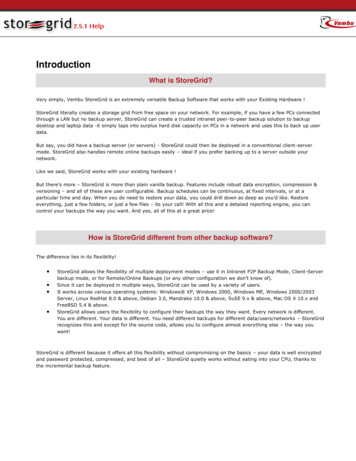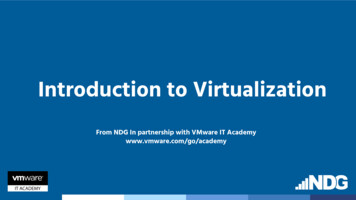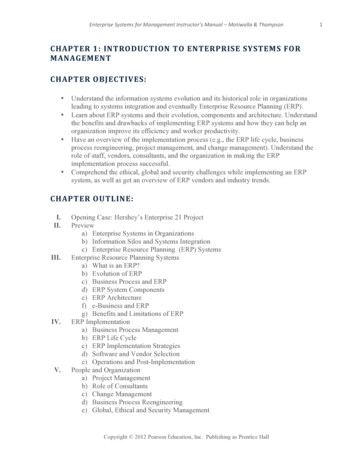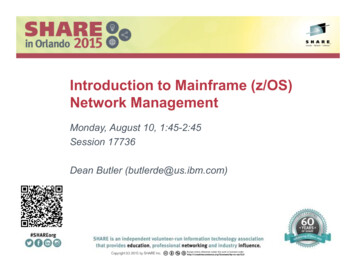
Transcription
IntroductionWhat is StoreGrid?Very simply, Vembu StoreGrid is an extremely versatile Backup Software that works with your Existing Hardware !StoreGrid literally creates a storage grid from free space on your network. For example, if you have a few PCs connectedthrough a LAN but no backup server, StoreGrid can create a trusted intranet peer-to-peer backup solution to backupdesktop and laptop data -it simply taps into surplus hard disk capacity on PCs in a network and uses this to back up userdata.But say, you did have a backup server (or servers) - StoreGrid could then be deployed in a conventional client-servermode. StoreGrid also handles remote online backups easily – ideal if you prefer backing up to a server outside yournetwork.Like we said, StoreGrid works with your existing hardware !But there‟s more – StoreGrid is more than plain vanilla backup. Features include robust data encryption, compression &versioning – and all of these are user configurable. Backup schedules can be continuous, at fixed intervals, or at aparticular time and day. When you do need to restore your data, you could drill down as deep as you‟d like. Restoreeverything, just a few folders, or just a few files – its your call! With all this and a detailed reporting engine, you cancontrol your backups the way you want. And yes, all of this at a great price!How is StoreGrid different from other backup software?The difference lies in its flexibility!StoreGrid allows the flexibility of multiple deployment modes – use it in Intranet P2P Backup Mode, Client-Serverbackup mode, or for Remote/Online Backups (or any other configuration we don‟t know of).Since it can be deployed in multiple ways, StoreGrid can be used by a variety of users.It works across various operating systems: Windows XP, Windows 2000, Windows ME, Windows 2000/2003Server, Linux RedHat 8.0 & above, Debian 3.0, Mandrake 10.0 & above, SuSE 9.x & above, Mac OS X 10.x andFreeBSD 5.4 & above.StoreGrid allows users the flexibility to configure their backups the way they want. Every network is different.You are different. Your data is different. You need different backups for different data/users/networks – StoreGridrecognizes this and except for the source code, allows you to configure almost everything else – the way youwant!StoreGrid is different because it offers all this flexibility without compromising on the basics – your data is well encryptedand password protected, compressed, and best of all – StoreGrid quietly works without eating into your CPU, thanks tothe incremental backup feature.
StoreGrid Features1. Data Backup1.Automatically detects changes in files and/or directories and backs upaccordingly2. Mobile (laptop) users' data can be backed up immediately as they connect tothe LAN3. Hot links provided for windows registry backup and windows system filesbackup, among others4. Versioning support for backing up multiple versions of the same file5. Incremental backups supported: backs up only changes in files and not theentire file every time. This saves bandwidth and time6. Supports multiple periodical full backups and incremental backups in betweentwo full backups7. Supports MySQL Backup in Linux8. Quick restore capability: end users can easily restore their data up to the filelevel9. Optional compression of backed up data possible: saves disk space and networkbandwidth10. Support for auditing User Operations11. Support for non-English PCs2. Data Security1.2.3.Encryption support provided to protect users' personal dataRobust encryption based on the blowfish algorithmAuthentication support between StoreGrid client and server3. Deployment Flexibility1.2.3.4.Trusted intranet P2P backup deploymentTypical client-server backup deploymentRemote backup with StoreGrid server residing outside the intranetPermutations & combinations of 1,2 and 34. Supported Platforms 1.2.3.4.5.6.7.StoreGrid is platform independent and supports the following operating systemsWindows Vista, Windows XP, Windows 2000, Windows 2000/2003 SBS/2003ServerDebian Linux 3.0Mandrake Linux 10.0 and aboveRedHat Linux 8.x and aboveSuSE Linux 9.x and aboveMac OS X 10.xFreeBSD 5.4 and above5. Supported Browsers -StoreGrid requires one of the following browsers to be installed in the system
1.2.3.4.5.6.Internet Explorer 5.5 and aboveFirefox 1.0 and aboveNetscape 7.0 and aboveOpera 7.01 and aboveMozilla 1.5 and aboveSafari 1.2.4 and above
TerminologyThese are some terms we use quite liberally – both in this document, and in our user interface. So here‟s a shortdescription of what each of them means.StoreGrid General Terminology:StoreGrid Server:A StoreGrid Server receives (and stores) backup data from StoreGrid Clients.The backed up data is stored in the machine which runs the StoreGrid Server – a PC can run StoreGrid server ifyou plan to store data on that PC.If you wish, the same machine can run StoreGrid Server and StoreGrid Client. This would be the case in a true P2Pdeployment, or if you have a backup server that will in turn be backed up, as well.StoreGrid Client:A machine that has data it wants to back up has to run StoreGrid Client.The StoreGrid Client backs up its data on to a machine running StoreGrid Server.If you wish, the same machine can run StoreGrid Server and StoreGrid Client. This would be the case in a true P2Pdeployment, or if you have a backup server that will in turn be backed up, as wellStoreGrid ID:This is the unique ID each installation of StoreGrid is identified with. StoreGrid will prompt you to give an ID duringthe installation. It will automatically take the machine name as the StoreGrid ID by default.(anyone who purchases a paid license of Vembu StoreGrid is also a StoreGrid client)Client-Server:A Client-Server architecture is a concept in which many clients are served by a single or multiple servers. In thecontext of Vembu StoreGrid, multiple clients (Desktops) can backup to a single Backup Server or multiple BackupServers.The Backup Servers are generally dedicated to a particular purpose, in this case, to store the backed up data.Replication:Term used for the process where a backup server sends its backup data to a replication server to create aredundant copy of the backup data.StoreGrid Replication Server:A machine that receives replication data from a backup server. In case the backup server crashes, it can berestored from the replicated data in the replication server. A backup server can replicate to only one replicationserver. A replication server can accept replication from more than one backup servers.StoreGrid Web Console:This is the browser based StoreGrid user interface from which the backup, restore and administration of StoreGridservers and clients are done.Since the user interface is browser based, any StoreGrid Client or Server can be configured and administered from
any location.Peer-to-Peer (P2P):In P2P, individual entities like Desktops (Peers) exchange information with each other without the help of a centralserver. In a true P2P architecture, all peers are equal and participate in some form of network activity. In the caseof Vembu StoreGrid, which can be deployed in a P2P fashion, the Peers (Desktops) use each others free disk spaceto backup data between each other. In the case of a true P2P deployment both the StoreGrid Server and theStoreGrid Client will run in the same machine as a single process.Remote / Online Backups :The same as client-server (see above), except that the „server‟ is outside the clients‟ network.
Deployment ScenariosOne of the unique features of Vembu StoreGrid is the deployment flexibility it offers. This flexibility makes it suitable for abroad spectrum of users.Depending upon their existing/planned Backup & Storage infrastructure, users can choose a suitable type of deployment (ordo a mix and match type of deployment)1.2.3.Service Provider Hosted Remote Online Backup DeploymentPeer-to-Peer(P2P) or Grid deploymentDedicated Backup Server deployment (Client-Server)Service Provider Hosted Remote Online Backup DeploymentOnline Backup service provider including MSPs, VARs, SIs etc. can use this deployment to offer an online backup service totheir customers. This deployment mode is supported in the StoreGrid Service Provider Edition. Typically, the serviceprovider will install StoreGrid in server mode in the data center and install StoreGrid from a custom Client Only installation(provided by Vembu) in the customer PCs. The Service Provider Edition supports comprehensive customer basedmanagement of backup clients, storage, reports etc.Peer-to-Peer or Grid Deployment (P2P Backup)In a true P2P deployment StoreGrid can be configured to run both the server and the client in all the desktops or laptopsthat need to be backed up, thus forming a StoreGrid P2P network. Each individual Peer can then be configured to backup toone (or more) other peers. This deployment is the most cost-effective solution as it does not require a dedicated backupstorage server (and the associated expenses). This is perfect for Home, SoHo, & Small businesses where it is easy to set upa trusted peer-to-peer StoreGrid Backup network. In general, laptops are not suitable for storing other peers' backup sincethe laptop may not be on the network when needed! So, it is advisable not to configure a laptop as a StoreGrid Server, butrun it only in Client mode. In such cases where all peers do not store backup data, the deployment is still a „Peer-to-Peerdeployment‟- but one where all peers are not „equal‟.Dedicated Backup Server deployment (Client-Server / Remote Online Backups)This is a more traditional deployment - ideal for leveraging existing backup infrastructure by allowing customers to includedesktop and laptop data.All the desktops and laptops run the StoreGrid in Client mode only, and they all back up their data to a central backupstorage server. The backup storage server alone runs the StoreGrid in Server mode. It is also possible to have more than
one backup server for additional data protection. The backup storage server can also be deployed in a remote location tosupport remote/online backup and disaster recovery.
NAT/Firewall ConfigurationThis page provides information about the ports used by StoreGrid, and details on what ports need to be opened to enableStoreGrid to work across different networks behind a NAT/Firewall.TCP Port 32004StoreGrid Server opens this port. All Client-Server communication including backups, restore etc. (except TCP discovery) isdone through this port. If a StoreGrid Server is behind a NAT/Firewall then this port needs to be opened to enable StoreGridclients to backup to this server. Opening up this port is mandatory for the core functionality of backup and restore to work inStoreGrid. By default the port used by StoreGrid is 32004, if you have modified the 'Backup Server Port' during installation,then you have to open the corresponding port in your NAT/Firewall.TCP SSL Port 32007From StoreGrid v2.3, StoreGrid clients can send the backup data to the backup server on secure SSL port 32007. This port isdisabled in the backup server and the client by default. SSL port can be enabled by changing the Enabled attribute to 1 in th eSSL tag in the SGConfiguration.conf file. When enabled in the backup server, the StoreGrid backup server can accept backuprequests on both port 32004 and the SSL port 32007. When enabled in the client, the client will start sending the backup dataon the SSL port.If SSL port is enabled in the backup server and in the client, all Client-Server communication including backups, restore etc.(except TCP discovery) from that client will be done through the SSL port 32007 and therefore if a StoreGrid Server is behinda NAT/Firewall then this port needs to be opened to enable the StoreGrid client to backup to this server.By default the port used by StoreGrid for SSL is 32007. But it can be modified by changing the 'SSLServer' attribute in the'Ports' tag in the SGConfiguration.conf file. This port number should be set the same in both the server and the client.TCP Port 32008(Windows 64-bit OS)From StoreGrid v2.4 Exchange Mailbox backup and restore is supported for Exchange Server 2007. StoreGrid 64-bit client execan send the backup request to the 32-bit client exe on port 32008 running in the same machine. If a StoreGrid Client isbehind a NAT/Firewall then this port needs to be opened to enable Exchange 2007 Mailbox backup and restore to beperformed. Opening up this port is mandatory for the core Exchange 2007 Mailbox functionality of backup and restore to workin StoreGrid. By default the port used by StoreGrid for Exchange 2007 Mailbox backup is 32008. But it can be modified bychanging the "e;MAPI32Bit"e; attribute in the "e;Ports"e; tag in the SGConfiguration.conf file located in SG Home /conffolder.TCP Port 32005Both StoreGrid Client and Server open this port. This port is used for two purposes:1.2.For all communication between the PHP module (invoked by the StoreGrid browser based WebConsole) and theStoreGrid C modules. In StoreGrid, all UI requests from the browser are served by PHP pages, which in turnconnect to this port to get the required data. By default the port used by StoreGrid is 32005, if you have modified the'UI Communication Port' during installation, then you have to open the corresponding port in your NAT/Firewall.StoreGrid peers also use this port to do a more complete discovery of each other sharing details about other peersetc. This TCP discovery is always enabled in StoreGrid.This port need not be configured in the NAT/Firewall. If so, the only feature that would not work is: Switching to a StoreGridpeer behind the NAT/Firewall through the WebConsole of another StoreGrid peer outside the NAT/Firewall.TCP Port 6060, 6061These ports are used by the StoreGrid Web Server (Apache) to serve requests from StoreGrid WebConsole (User Interface).These ports are configurable. When you first install StoreGrid you would have been given an option to change these ports. TheNAT/Firewall should also 'allow' these ports if you need the ability to connect/administer a StoreGrid peer behind theNAT/Firewall.
Multicast Ports (UDP) 6363, 6364These two multicast ports are used by StoreGrid Clients and Servers for discovering peers within a subnet. In most networks,multicasting will work only within a subnet. There is no need to open these ports in firewall or NAT devices as multicastpackets may not be sent across networks, anyway. Multicast discovery is enabled by default in StoreGrid.UDP Port 32006This UDP port is used in discovery of StoreGrid peers in a network. StoreGrid does a UDP scanning on port 32006 of allpossible IP Addresses in a network to detect the presence of other StoreGrid peers. There is no need to open this p ort in theNAT/firewall as StoreGrid does the UDP scanning only within its subnet. By default, UDP network scanning is disabled inStoreGrid.
Vembu StoreGrid Troubleshooting GuideDescription of the Error CodesCommon StoreGrid Error Codes and their corresponding description are listed below. If you require furtherclarification on these or if you encounter a different error code from those listed below, contact us at storegridsupport@vembu.comError CodesWhat does this error code mean?SG0083This error occurs when :The socket connection between the Client and the Server gets disconnected due to anyexternal force such as an Internet Link error, Intrusion Detection software, Antivirussoftware or NAT/Firewall Idle socket configuration.Exceeding allotted backup space in the server.SG0198This error occurs when the socket connection between the Client and the Server getsdisconnected due to any external force such as a. Internet Link error, b. IntrusionDetection software, c. Antivirus software, d. NAT/Firewall Idle socket configuration.SG0145/SG0134Problem in resolving Backup Server Name and IP Address, DNS Lookup for BackupServer Name or IP Address failed.SG0147/SG0136Problem in connecting to Backup Server, Backup Port (32004) not opened up inNAT/Firewall or StoreGrid not running.SG0200No drive space available in the Backup Server to continue the backupsSG0191Active backup is suspended in the client or the Backup ServerSG0178Exceeding allotted backup space in Backup ServerSG0180Backup space not configured for the client in the Backup ServerSG0601Failed to initialize the compression module to compress file contents for backupSG0094Unable to read the file during time of backupSG0290Backup schedule is active during delete schedule configuration, suspend the backup andschedule deleteSG0291Backup schedule Restore is active during delete schedule configuration, suspend thebackup and schedule deleteSG0292Backup schedule Delete is in progress, Delete schedule updatedSG0170Unable to send out delete request to Backup Server for deletion of backup data fromclientSG0132Invalid remote socket.SGRP0001No Server available for Replication.Error Code 21Cannot Start Storegrid or Error in Starting StoreGrid.StoreGrid reports an error "Unable to list the Exchange mailbox users. Make sure sufficient permissions areavailable for the user account under which StoreGrid service is running. Exchange Mail Level Backup requires theuser account to have 'Full Control' access to the Exchange Server to list the mailbox users." while trying toconfigure mailbox level backup.Resolution :If you encounter an error while accessing "Create Exchange Mailbox Backup" page in the StoreGrid webconsole, thenfollow the steps given below to resolve the issue:a)b)c)Create a new user with sufficient rights through Active Directory Users and Computers.Assign "Full Mailbox Access" permission to that new user.Add that new user in the 'PluginConfiguration.conf' file located in " SG Home /plugins" folder.
d)Add the 'MSPST MS' service by modifying the MAPISVC.INF file.(NOTE: above 3 steps should resolve the issue in listing the Mailbox users in the "Create ExchangeMailbox Backup" page. However 'MSPST MS' service should be added in the MAPISVC.INF file tosuccessfully backup the Exchange users mailbox).Please refer Granting Mailbox Rights document on creating a new user and granting the sufficient rights to access themailboxes.StoreGrid reports an error "Unable to list the Exchange mailbox users." when trying to configure ExchangeMailbox level backup in 2007 Exchange server (64 bit) machines.Resolution :StoreGrid uses Microsoft's MAPI client component installed in the Exchange Server to backup the ExchangeMailboxes. For 64-bit environment the MAPI client component is yet to be released by Microsoft. Currently, StoreGriduses its 32-bit exe to list, backup and restore the Exchange Mailboxes in 64-bit machines. To accomplish this,StoreGrid 32-bit exe requires Microsoft's 32-bit MAPI client component.Please refer Granting Mailbox Rights document on creating a new user and granting the sufficient rights to access theExchange 2007 mailboxes.SG0147/SG0136: Unable to connect to the Backup ServerCause:This error occurs whena)b)Client is not able to connect to the Backup Server's Backup Port (default 32004).StoreGrid is not started in the server machine, therefore Backup Port (default 32004) is notoccupied by StoreGrid.Resolution:a)b)c)d)e)f)g)Confirm if the client is able to connect the Backup Server's Backup Port (default 32004) byexecuting telnet Server Name/IP Address Backup Port command in the StoreGrid Clientsystem through the command prompt.If the telnet command doesn't work, then check the firewall configuration of the StoreGrid Serverand make sure the Backup Port (default 32004) is open for the incoming traffic.Check that the StoreGrid server is running in your StoreGrid Server machine and the Backup Port isin LISTEN state by executing netstat -an find Backup Port [in Windows OS] or netstat -an grep Backup Port [in Linux OS] in StoreGrid Backup Server system.If Backup Port is not in LISTEN state, start the StoreGrid in the Backu
Very simply, Vembu StoreGrid is an extremely versatile Backup Software that works with your Existing Hardware ! StoreGrid literally creates a storage grid from free space on your network. For example, if you have a few PCs connected through a LAN but no backup server, StoreGrid can create











